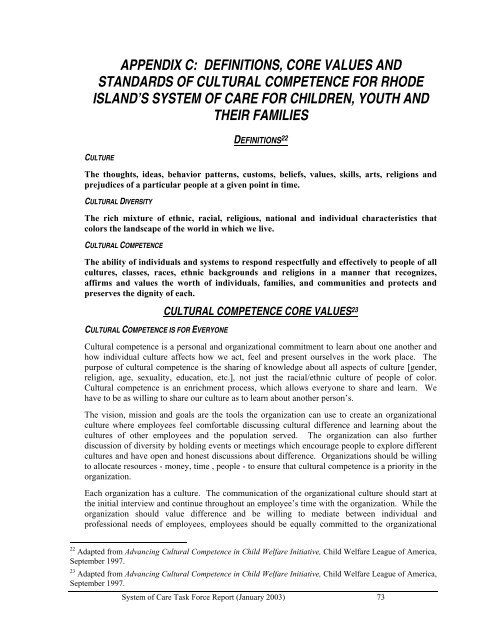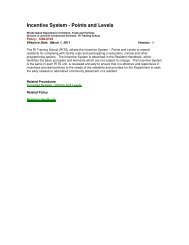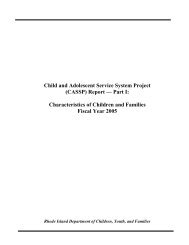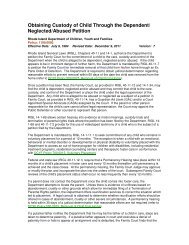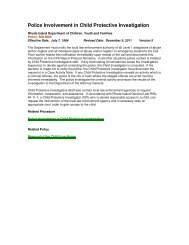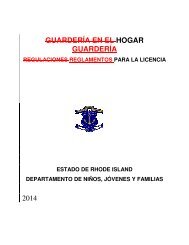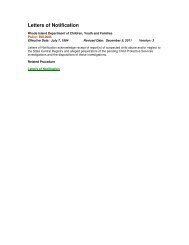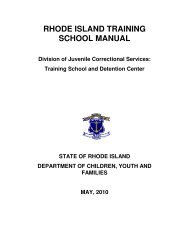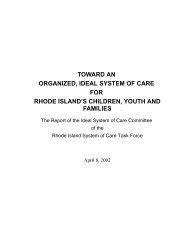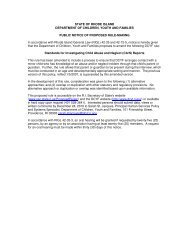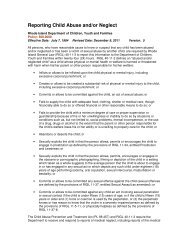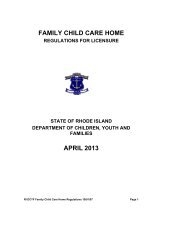Final Report - RI Department of Children, Youth & Families
Final Report - RI Department of Children, Youth & Families
Final Report - RI Department of Children, Youth & Families
Create successful ePaper yourself
Turn your PDF publications into a flip-book with our unique Google optimized e-Paper software.
APPENDIX C: DEFINITIONS, CORE VALUES AND<br />
STANDARDS OF CULTURAL COMPETENCE FOR RHODE<br />
ISLAND’S SYSTEM OF CARE FOR CHILDREN, YOUTH AND<br />
THEIR FAMILIES<br />
CULTURE<br />
DEFINITIONS 22<br />
The thoughts, ideas, behavior patterns, customs, beliefs, values, skills, arts, religions and<br />
prejudices <strong>of</strong> a particular people at a given point in time.<br />
CULTURAL DIVERSITY<br />
The rich mixture <strong>of</strong> ethnic, racial, religious, national and individual characteristics that<br />
colors the landscape <strong>of</strong> the world in which we live.<br />
CULTURAL COMPETENCE<br />
The ability <strong>of</strong> individuals and systems to respond respectfully and effectively to people <strong>of</strong> all<br />
cultures, classes, races, ethnic backgrounds and religions in a manner that recognizes,<br />
affirms and values the worth <strong>of</strong> individuals, families, and communities and protects and<br />
preserves the dignity <strong>of</strong> each.<br />
CULTURAL COMPETENCE IS FOR EVERYONE<br />
CULTURAL COMPETENCE CORE VALUES 23<br />
Cultural competence is a personal and organizational commitment to learn about one another and<br />
how individual culture affects how we act, feel and present ourselves in the work place. The<br />
purpose <strong>of</strong> cultural competence is the sharing <strong>of</strong> knowledge about all aspects <strong>of</strong> culture [gender,<br />
religion, age, sexuality, education, etc.], not just the racial/ethnic culture <strong>of</strong> people <strong>of</strong> color.<br />
Cultural competence is an enrichment process, which allows everyone to share and learn. We<br />
have to be as willing to share our culture as to learn about another person’s.<br />
The vision, mission and goals are the tools the organization can use to create an organizational<br />
culture where employees feel comfortable discussing cultural difference and learning about the<br />
cultures <strong>of</strong> other employees and the population served. The organization can also further<br />
discussion <strong>of</strong> diversity by holding events or meetings which encourage people to explore different<br />
cultures and have open and honest discussions about difference. Organizations should be willing<br />
to allocate resources - money, time , people - to ensure that cultural competence is a priority in the<br />
organization.<br />
Each organization has a culture. The communication <strong>of</strong> the organizational culture should start at<br />
the initial interview and continue throughout an employee’s time with the organization. While the<br />
organization should value difference and be willing to mediate between individual and<br />
pr<strong>of</strong>essional needs <strong>of</strong> employees, employees should be equally committed to the organizational<br />
22 Adapted from Advancing Cultural Competence in Child Welfare Initiative, Child Welfare League <strong>of</strong> America,<br />
September 1997.<br />
23 Adapted from Advancing Cultural Competence in Child Welfare Initiative, Child Welfare League <strong>of</strong> America,<br />
September 1997.<br />
System <strong>of</strong> Care Task Force <strong>Report</strong> (January 2003) 73


